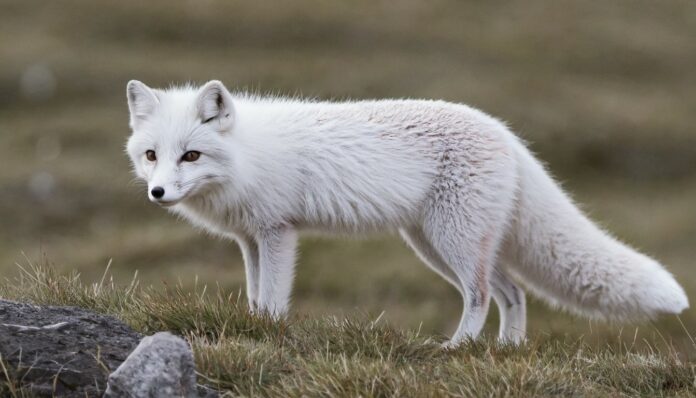The Arctic fox, also known as the snow fox or white fox, is a small mammal native to the Arctic regions of the Northern Hemisphere. Scientifically known as Vulpes lagopus, the Arctic fox is well adapted to its cold environment.
- Fur:
- The Arctic fox has thick fur that changes color with the seasons. In winter, its fur is white to blend in with the snow, and in summer, it becomes brown or gray to match the tundra’s landscape.
- Size:
- Arctic foxes are small, typically weighing between 6 to 10 pounds (2.7 to 4.5 kg). They are about 18 to 27 inches (45 to 70 cm) in length, with a bushy tail that adds another 12 inches (30 cm).
- Adaptations:
- Their fur provides excellent insulation against the cold, and they have small ears and short legs to minimize heat loss. Their paws are covered with fur, which helps them walk on snow and ice.
Interesting facts about the Arctic fox
- The average weight of an Arctic fox is 3.5-4 kg, although some individuals can reach a weight of 9 kg.
- Arctic foxes can survive extreme cold temperatures as low as -58°F (-50°C). Their fur provides insulation, and they have a high-fat diet that helps them store energy.
- They are known to travel long distances in search of food. Some Arctic foxes have been recorded traveling over 1,000 miles (1,600 km).
- Their seasonal color change is one of the most striking examples of natural camouflage in the animal kingdom, helping them evade predators and surprise prey.
- The Arctic fox’s ears barely protrude from its fur, protecting them from frostbite.
- With the onset of winter, Arctic foxes move to southern regions, which also have quite harsh conditions.
- The Arctic fox is widely distributed beyond the Arctic Circle and along the coasts of the Arctic Ocean.
- These animals form pairs but separate for the winter since it is easier for them to survive alone rather than together.
- The Arctic fox lives in a den that resembles a complex labyrinth with many exits. It can live in such a den for up to 20 years.
- The Arctic fox never digs a den more than 500 meters from a water source.
- If the snow in the Arctic fox’s habitat has a grayish tint, the animal’s fur will be a similar color.
- The number of offspring a female can give birth to directly depends on the availability of food. In favorable conditions, a pair can have up to 25 offspring, a record among all mammal species.
- Arctic foxes often fall prey to polar bears (see interesting facts about polar bears).
- The Arctic fox is an omnivorous predator, eating both plant and animal foods.
- If an Arctic fox fails to build up enough fat reserves for winter, it is likely to die of starvation.
- Making an average Arctic fox fur coat requires killing about 20 Arctic foxes.
- When food is scarce, the Arctic fox can feed on carrion.
- The Arctic fox has poor vision but possesses excellent hearing and sense of smell.
- During times of food scarcity, the Arctic fox can slow its metabolism by almost half, without affecting its activity.
- Arctic foxes are often hunted by wild birds (see interesting facts about birds).
- During seasonal migrations, the Arctic fox can travel up to 4000 km.
- If the parents die, the pups are rarely left unattended, as other animals will take care of them, feeding them along with their own offspring.
- A significant portion of the Arctic fox’s diet consists of lemmings, so if this prey population decreases, the foxes can starve.
- In Iceland, the Arctic fox is considered the only terrestrial mammal living in natural conditions.
Despite the harsh environments they inhabit, Arctic foxes have adapted remarkably well, exhibiting fascinating behaviors and survival strategies. Their ability to camouflage, endure extreme cold, and adjust their metabolic rates are just a few examples of their resilience. Conservation efforts are crucial to ensure these incredible creatures continue to thrive in their natural habitats.
